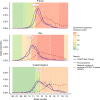Smell and taste changes are early indicators of the COVID-19 pandemic and political decision effectiveness
- PMID: 33056983
- PMCID: PMC7560893
- DOI: 10.1038/s41467-020-18963-y
Smell and taste changes are early indicators of the COVID-19 pandemic and political decision effectiveness
Abstract
In response to the COVID-19 pandemic, many governments have taken drastic measures to avoid an overflow of intensive care units. Accurate metrics of disease spread are critical for the reopening strategies. Here, we show that self-reports of smell/taste changes are more closely associated with hospital overload and are earlier markers of the spread of infection of SARS-CoV-2 than current governmental indicators. We also report a decrease in self-reports of new onset smell/taste changes as early as 5 days after lockdown enforcement. Cross-country comparisons demonstrate that countries that adopted the most stringent lockdown measures had faster declines in new reports of smell/taste changes following lockdown than a country that adopted less stringent lockdown measures. We propose that an increase in the incidence of sudden smell and taste change in the general population may be used as an indicator of COVID-19 spread in the population.
Conflict of interest statement
The authors declare no competing interests.
Figures


References
Publication types
MeSH terms
LinkOut - more resources
Full Text Sources
Medical
Miscellaneous

